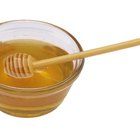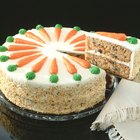
Shortening, made from solidified and hydrogenated vegetable oils, gives you a substitute for butter and oil in a recipe. Most shortening is flavorless, although butter-flavored versions are available. When you use shortening in recipes that call for melted butter or shortening, you can melt it using the same method used for butter. Shortening has a higher melt temperature than butter, so it can withstand more heat and may take longer to melt completely.
Step 1
Measure the amount of shortening needed for the recipe into a medium-size saucepan. If you have sticks of shortening, cut the measured stick amount into 1/2-inch-thick slices to speed melting.
Step 2
Heat the pan over medium heat. The shortening will begin to melt when the temperature approaches 117 degrees Fahrenheit.
Step 3
Stir the shortening constantly with a spoon as it melts, so the heat stays evenly distributed and the shortening doesn't scorch. Pour the shortening into a separate bowl once it has melted so it doesn't continue to cook, and possibly scorch, in the heated pan.
Related Articles

How to Make Cake Frosting Into a ...
How to Make Ready Made Frosting Into a ...

How to Substitute Oleo for Cooking Oil ...
How to Make White Drizzle Frosting

Homemade Coconut Pomade

How Many Calories Are in Peanut M&Ms?

How to Make Chocolate Ganache With ...

How Long Do You Bake Brownie Cupcakes ...

How to Make Toasted Bread Sticks With ...

How to Liquify Honey

How to Make Fresh Strawberry Frosting ...

How to Heat Frosting

What Are Good Substitutes for Vegetable ...
How to Make Drizzle Icing From Frosting ...

How to Troubleshoot Seven Minute ...

What Can I Substitute for Butter When ...

How Do I Curdle Soy Milk With Lemon ...

Easy No-Bake or Stove Top Snacks & ...

How to Cook a Frozen Beef Patty ...

How to Make Creamy Alfredo Sauce With ...
References
Tips
- For quicker melting, place the shortening in a microwave-safe bowl and microwave it in 20-second increments until it melts to the desired consistency.
- Vegetable shortening will re-solidify after melting when it sits at room temperature, so melt it immediately before you'll use it.
Writer Bio
Jenny Harrington has been a freelance writer since 2006. Her published articles have appeared in various print and online publications. Previously, she owned her own business, selling handmade items online, wholesale and at crafts fairs. Harrington's specialties include small business information, crafting, decorating and gardening.
Photo Credits
Jupiterimages/Goodshoot/Getty Images